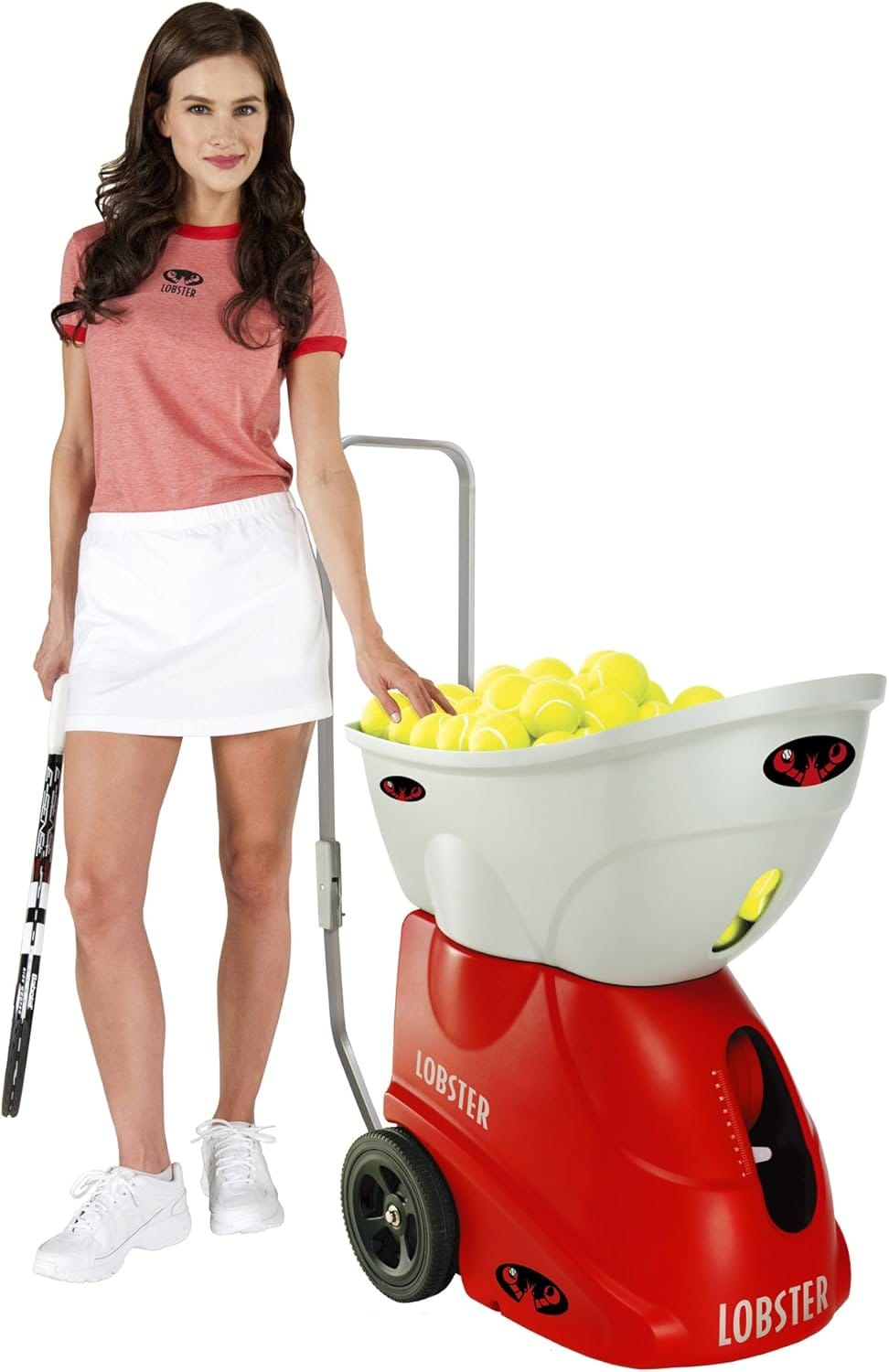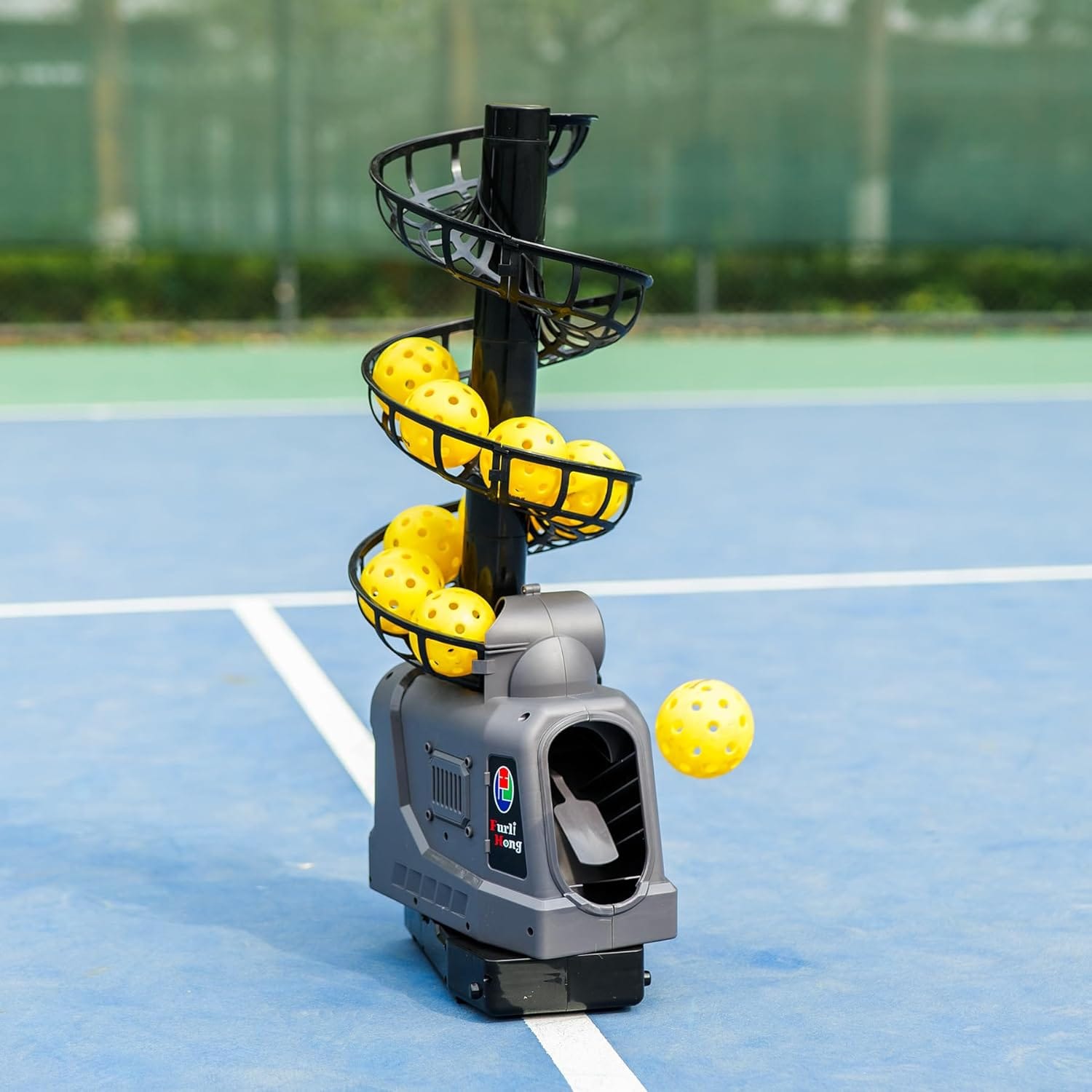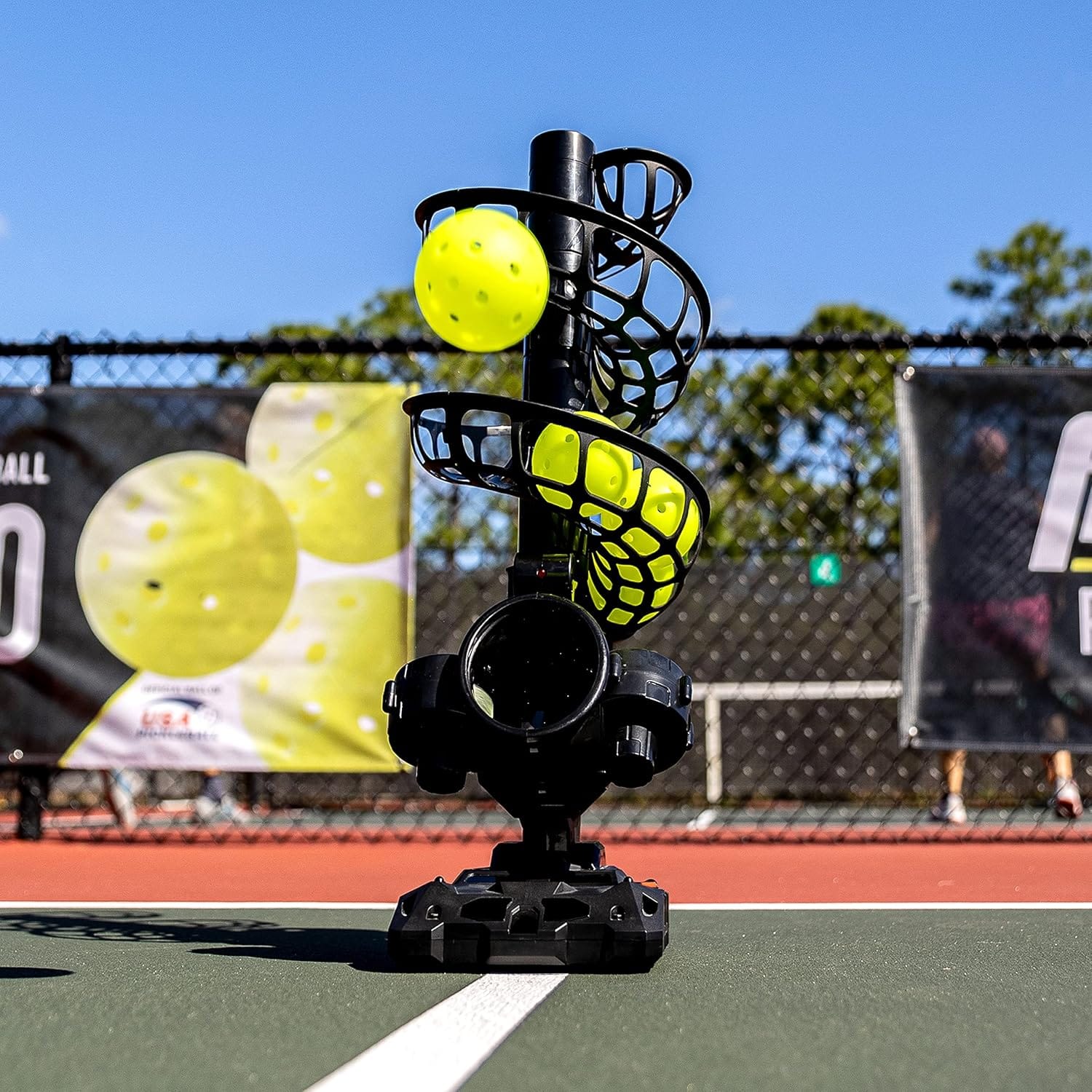Pickleball Ball Machine For The Ultimate Practice Experience
Pickleball ball machine can provide a challenging and varied practice experience for players of all skill levels. With many different models available, players can find a machine that fits their needs, preferences, and budget and start improving their game today.

Pickleball has rapidly gained popularity for its fun, fast-paced gameplay and its appeal to players of all ages. As the sport grows, so does the demand for equipment that can help players improve their skills. One such invaluable tool is the pickleball ball machine.
Whether you’re a beginner looking to practice basic shots or an advanced player aiming to refine your technique, a pickleball ball machine can provide consistent, repetitive practice that is crucial for improvement. In this article, we’ll explore the benefits of using a pickleball ball machine, the key features to look for, and how it can elevate your game to the next level.
Buyer's Guide: Best Pickleball Ball Machine
Investing in a pickleball ball machine can elevate your game by providing consistent practice and improving your skills. However, choosing the right one can be a daunting task. Here's a comprehensive guide to help you find the best pickleball ball machine for your needs.
1. Types of Pickleball Ball Machines
Pickleball ball machines come in different types, catering to various needs and skill levels. The two main types are:
- Basic Machines: Ideal for beginners, these machines offer fundamental features such as consistent ball feed and basic oscillation.
- Advanced Machines: Perfect for intermediate and advanced players, these machines provide features like variable speed, spin options, programmable drills, and more complex oscillation patterns.
2. Key Features to Consider
When selecting a pickleball ball machine, consider the following key features to ensure it meets your practice requirements:
a. Speed and Spin Control
- Speed Range: Look for a machine with a wide range of speeds to simulate different playing scenarios.
- Spin Options: Machines that offer topspin and backspin can help you practice returning various types of shots.
b. Oscillation and Elevation
- Oscillation: Machines with horizontal and vertical oscillation can simulate different ball placements, helping you practice moving around the court.
- Elevation Control: Adjustable elevation allows you to practice high and low shots, including lobs and volleys.
c. Feed Rate
- Adjustable Feed Rate: This feature lets you control the interval between shots, enabling you to practice at your own pace.
3. Portability and Battery Life
Consider the portability and battery life of the machine, especially if you plan to use it in different locations or for extended practice sessions:
- Weight and Size: Lightweight and compact machines are easier to transport and store.
- Battery Life: Ensure the machine has a long-lasting battery or offers a convenient power source to avoid interruptions during practice.
4. Durability and Build Quality
Invest in a machine that is built to last. Check for:
- Robust Construction: Machines made from high-quality materials tend to be more durable and withstand frequent use.
- Warranty: A good warranty can provide peace of mind and protection against defects.
5. User-Friendly Controls
Easy-to-use controls are crucial for a smooth practice experience:
- Remote Control: Some machines come with a remote control for convenient adjustments during practice.
- Simple Interface: Look for machines with intuitive controls that allow you to easily change settings.
6. Cost and Value for Money
Pickleball ball machines can range from a few hundred to several thousand dollars. Consider your budget and the features you need:
- Basic vs. Advanced Features: Determine which features are essential for your practice and avoid paying for unnecessary extras.
- Long-Term Investment: Higher-priced machines with advanced features may offer better value in the long run if they enhance your practice and skill development.
7. Customer Reviews and Recommendations
Research customer reviews and seek recommendations from fellow players or coaches:
- Real-World Feedback: Reviews can provide insights into the machine's performance, reliability, and ease of use.
- Recommendations: Personal recommendations from trusted sources can guide you towards the best options.
Choosing the best pickleball ball machine involves considering your skill level, the features you need, portability, durability, user-friendly controls, and your budget. By evaluating these factors, you can find a machine that will help you practice effectively, improve your game, and provide long-lasting value. Happy practicing!
Lobster Pickleball Machine
Shop Now
Lobster Pickleball Machine
The Lobster Pickleball Machine is for players looking to improve their skills. It features a range of adjustable settings, including ball speed, spin, and trajectory, allowing players to customize their practice experience. The machine can hold up to 135 balls and has a battery life of up to four hours. It's also lightweight and easy to transport, making it an excellent option for players who travel to different courts.
The lightweight 8-inch all-terrain wheels make it easy to push or pull the machine over any surface. With an inverting hopper and folding handle, the liberty is easy to transport to and from the court in your trunk or even your car seat. With small footprint makes it easy to store in your garage, spare room, or closet. Folded down measurement: 29" x 21" x 15.5"
Sold by Amazon
681PBH Pickleball Machine
Shop Now
681PBH Pickleball Machine
- Automatic Pickleball Machine: Releases a ball every 4 seconds, with adjustable height from 3.6 ft to 7.0 ft and distance from 13.5 ft to 18 ft. Perfect for beginners to enhance their skills
- Challenge Your Game: Offers 3 adjustable angles, 4 speeds, and an auto-swing function for training your forehand and backhand to improve your skills.
- Multiple Power Supply Options: Can be powered by D batteries (not included), AC power, or a power bank (not included). Ideal for outdoor use without worrying about power sources. Remove batteries if using AC power.
- Expandable Ball Chutes: Holds up to 19 balls, expandable to accommodate more. Suitable for both 70 mm (2.7 in) and 74 mm (2.9 in) pickleball
- Complete Accessories: The set includes the machine, ball chutes, and more to meet your daily training needs
Sold by Amazon
Spinshot Pickleball Machine
Shop Now
SpinShot Pickleball Machine
The Spinshot Pickleball Machine is a high-quality option that offers a range of customizable settings. It can hold up to 120 balls and has adjustable settings for ball speed, spin, and trajectory. The machine also features a rechargeable battery with a life of up to six hours. Additionally, the Spinshot Pickleball Machine is designed to be lightweight and compact, making it easy to transport.
Sold by Amazon
Franklin Sports Automatic Pickleball Ball Machine
Shop Now
Franklin Sports Automatic Pickleball Ball Machine
The Franklin Sports ProShot Automatic Pickleball Launcher Machine is a compact, portable, and convenient piece of pickleball equipment to take your pickleball training to the next level. This easy-to-assemble pickleball tosser can hold up to 15 pickleballs at a time and will automatically launch them every 8-9 seconds. Practice your topspin, sidespin, backspin, serve to receive, volleys, and drinks with ease.
This portable pickleball launcher comes with a sturdy base and can be powered by 4 D batteries or the A/C power adaptor, so you can practice in the garage or out on the court. This machine is the perfect piece of pickleball training equipment to help all players develop their skills and play their best, so get your Franklin ProShot Automatic Pickleball launcher today and elevate your game!
Sold by Amazon
Pickleball Ball Machine FAQs
Q: Is a pickleball machine worth it?
Answer: Whether or not a pickleball machine is worth it depends on a variety of factors, including your level of commitment to the sport, your practice needs, and your budget.
For serious players who want to improve their skills and techniques, a pickleball machine can be a valuable investment. A machine provides a consistent and reliable practice experience, allowing players to work on specific shots and techniques at their own pace. Additionally, a machine can be used at any time, day or night, making it a convenient option for players with busy schedules.
On the other hand, if you are a more casual player or only play pickleball occasionally, a machine may not be necessary. You can often find practice partners at your local courts or join a pickleball club for more regular play. Additionally, a pickleball machine can be a significant expense, with prices ranging from a few hundred to several thousand dollars.
Ultimately, whether or not a pickleball machine is worth it is a personal decision. Consider your level of commitment to the sport, your practice needs, and your budget when deciding if a machine is right for you. If you do decide to invest in a machine, be sure to do your research to find one that meets your specific needs and budget.
Q: Can you use a tennis ball machine for pickleball?
Answer: In theory, a tennis ball machine could be used for pickleball. However, there are a few factors to consider.
First, tennis balls are larger and heavier than pickleballs, so a tennis ball machine may not be able to accommodate the smaller size and lighter weight of a pickleball. This could result in inaccurate shots and unpredictable ball behavior.
Second, tennis balls have a different level of bounce than pickleball. Pickleballs are designed to have a lower bounce, while tennis balls have a higher bounce. This difference in bounce could affect the way the machine shoots the ball, as well as the way the ball behaves when it hits the court.
Finally, tennis ball machines are typically designed to shoot balls at a higher speed than pickleball machines. This means that even if a tennis ball machine can shoot a pickleball accurately, it may do so at a speed that is too fast for many players to handle.
Overall, while it may be possible to use a tennis ball machine for pickleball, it is not recommended. It's best to use a machine specifically designed for pickleball, as these machines are designed to accommodate the unique size, weight, and bounce characteristics of pickleball, resulting in a more accurate and effective practice experience.
Q: What does a pickleball machine do?
Answer: A pickleball machine is a device that automatically shoots out pickleball at varying speeds, trajectories, and spins, allowing players to practice their shots and improve their game. It can be used to simulate the experience of playing with a partner, by providing a consistent and reliable feed of balls.
A typical pickleball machine consists of a hopper that holds a certain number of pickleballs, a mechanism that feeds the balls into the machine, and a system that propels the balls out of the machine. The machine can be adjusted to control the speed, trajectory, and spin of the balls, allowing players to practice a wide range of shots and techniques.
Pickleball machines come in a range of sizes and price points, from small, portable machines that can be easily transported, to larger, more expensive machines that offer more advanced features and capabilities. Some machines are battery-operated, while others must be plugged into an outlet.
Using a pickleball machine can be a valuable practice tool for players of all skill levels. It allows players to practice specific shots and techniques at their own pace and on their schedule, without the need for a practice partner. Additionally, it can provide a challenging and varied practice experience that can help players improve their game.
Q: What kind of ball is used in pickleball?
Answer: The ball used in pickleball is a plastic ball with holes, similar in appearance to a Wiffle ball. These balls are lightweight and have a slightly smaller diameter than a traditional tennis ball, with a diameter of 2.875 inches (about 7.3 cm) and a weight of 0.81 ounces (about 23 grams).
Pickleballs come in a variety of colors, including yellow, white, and orange, and they are available in both indoor and outdoor versions. The outdoor balls are typically harder and more durable to withstand the rougher surfaces of outdoor courts, while indoor balls are often softer and have more bounce for use on smoother surfaces.
The design of the pickleball, with its holes and lightweight construction, makes it ideal for the slower pace and shorter distance of pickleball games. The ball's unique flight characteristics, including its low bounce and susceptibility to wind, add to the strategy and challenge of the game.
Q: Is pickleball harder than tennis?
Answer: Whether or not pickleball is harder than tennis is a matter of personal opinion and depends on a variety of factors.
In terms of physical demands, both sports require players to move quickly and be in good physical condition, but the nature of the movements in each sport is different. Tennis players cover more ground during a match and need to be able to run long distances, change direction quickly, and be able to stop and start repeatedly. In contrast, pickleball requires players to move laterally more frequently and make quick, explosive movements at the net.
In terms of skill and technique, both sports require a high level of hand-eye coordination, footwork, and tactical thinking. However, the strokes and shots used in each sport are different. Tennis players need to master a range of groundstrokes, volleys, serves, and overheads, while pickleball players use a combination of dinks, volleys, and smashes to control the pace and placement of the ball.
Overall, it's difficult to say which sport is harder than the other, as the skills required and physical demands vary. It's best to try both sports and see which one you enjoy more and which one fits your abilities and interests.
